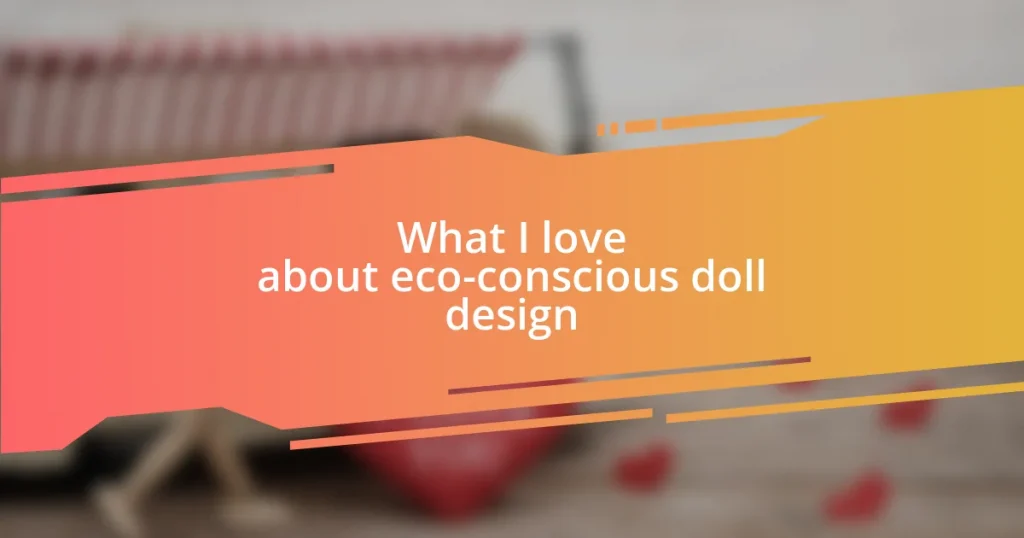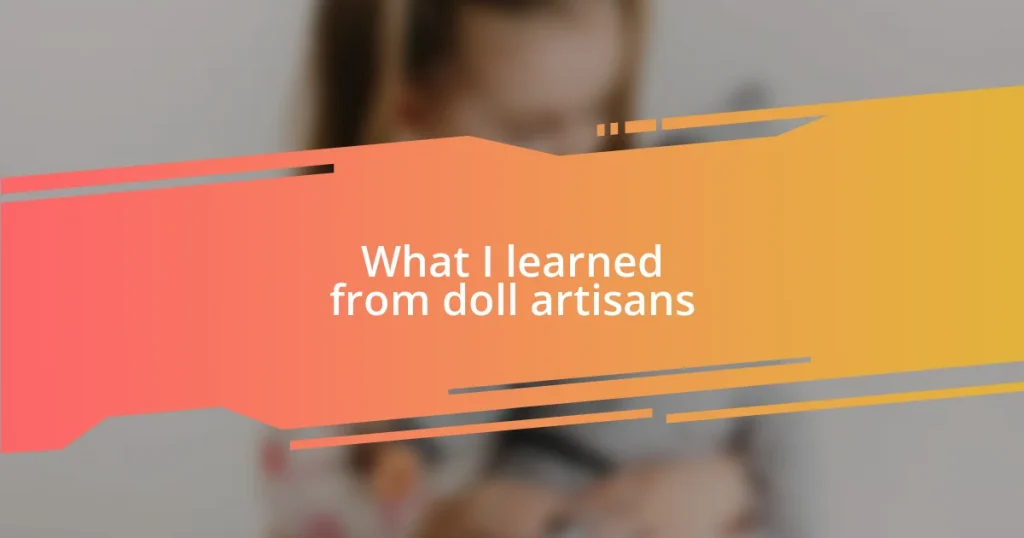Key takeaways:
- Eco-conscious doll design emphasizes sustainability through the use of natural, non-toxic materials, fostering a connection between play and environmental responsibility.
- Sustainable manufacturing practices prioritize renewable resources, non-toxic materials, and community involvement, resulting in safer, ethical toys that reflect diverse values.
- Future trends in eco-conscious dolls may include customizable designs, smart technology integration for storytelling, and a focus on social impact, encouraging children to engage with environmental issues creatively.
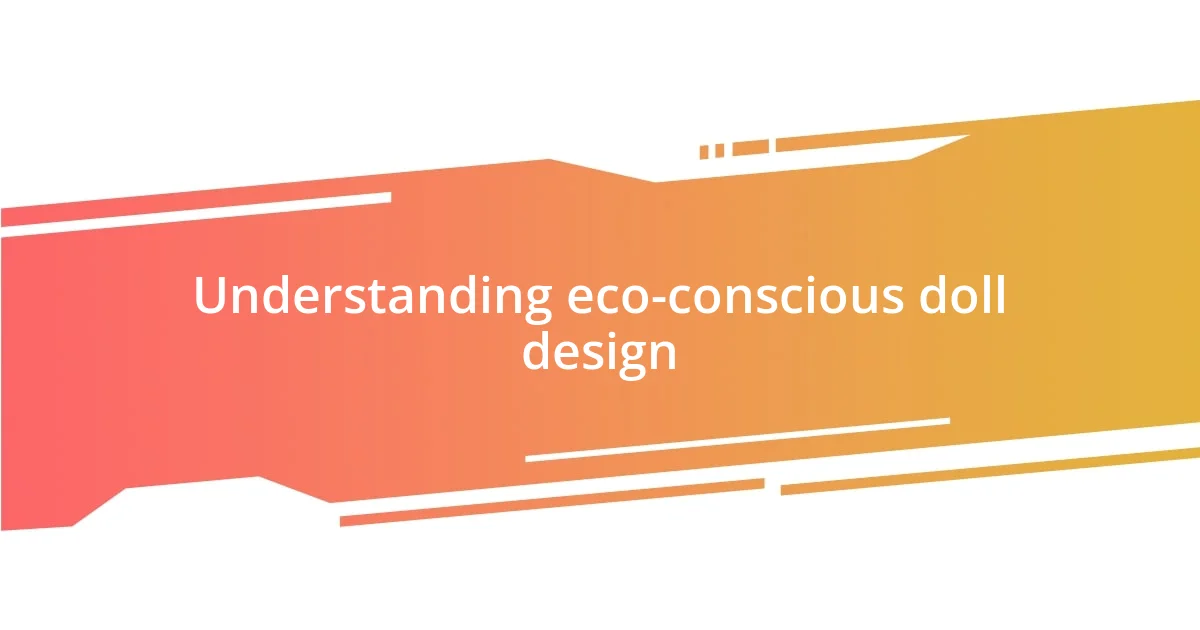
Understanding eco-conscious doll design
Eco-conscious doll design is deeply rooted in sustainability and a commitment to minimizing the environmental impact of toy production. I remember the first time I held a doll made from organic materials; it felt so different from the plastic ones I grew up with. There’s a certain warmth to these eco-friendly dolls that makes me think about the connection between what children play with and the planet we share.
The process often involves using natural, non-toxic materials, like sustainably sourced wood and organic cotton. This choice sparks a sense of responsibility in me—as if every doll is a tiny advocate for the Earth. When we choose eco-conscious toys, aren’t we also teaching the next generation to value and care for the environment? I often wonder how different my childhood could have been if I had been surrounded by toys that echoed the importance of sustainability.
Another fascinating aspect is how eco-conscious doll design encourages creativity and imagination. When I see children engage with dolls crafted from recycled materials, it brings a smile to my face. They don’t just see a toy; they see an opportunity to create stories around recycling and sustainability. Isn’t that a beautiful lesson bundled up in something so simple? It illustrates how eco-friendly choices can inspire a more thoughtful approach to consumption in the world of play.
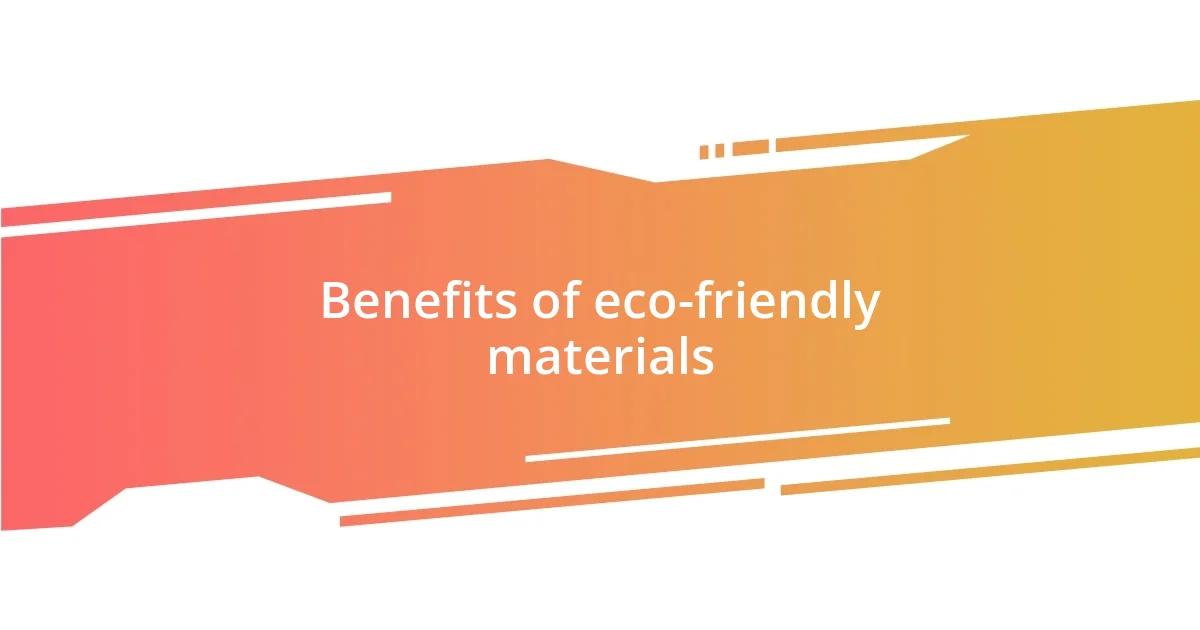
Benefits of eco-friendly materials
Shifting to eco-friendly materials in doll design offers numerous benefits, both for our health and the environment. I can recall a moment when I gifted my niece a doll made from organic cotton. The pure, soft texture not only reassured me about her safety but also made her delightfully happy. It’s amazing how the right materials can enhance the experience of play while keeping our little ones safe.
Consider these compelling advantages of using eco-friendly materials:
- Safety: Non-toxic, natural materials mean fewer chemicals that can affect children’s health.
- Sustainability: Many eco-friendly materials are biodegradable or recyclable, reducing waste in landfills.
- Durability: Many alternative materials, like sustainably sourced wood, can outlast conventional plastics, making the toys more long-lasting.
- Emotional Connection: Holding a doll made from natural fibers cultivates a sense of warmth and reassurance—something I really cherish when watching children bond with their toys.
- Educational Value: Eco-friendly dolls can be conversation starters about sustainability, teaching kids valuable lessons about caring for the planet.
Reflecting on these points, I feel inspired knowing that such small choices can contribute to a larger movement towards environmental mindfulness. Each eco-conscious doll represents a step towards nurturing a future filled with care and awareness for our Earth.
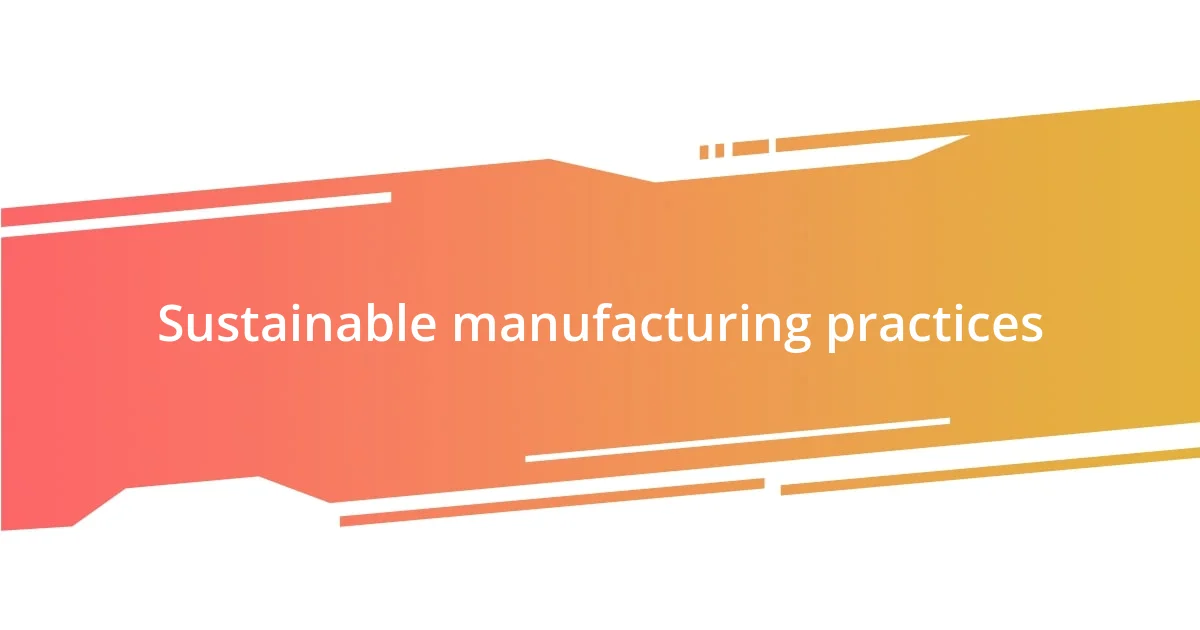
Sustainable manufacturing practices
Sustainable manufacturing practices in the world of eco-conscious doll design are fascinating because they directly reflect our shared commitment to the environment. I recently visited a workshop where dolls are made from recycled materials. The artisans spoke passionately about how they transform everyday waste into joyful playthings, which sparked thoughts about creativity born from necessity. It’s like they’re sending a message that sustainability can and should be an integral part of manufacturing, no matter how small the product.
Moreover, I’ve seen firsthand how brands are embracing renewable energy sources during production. When I learned that some companies run their facilities on solar power, I felt a sense of pride for supporting such initiatives. This aligns well with eco-conscious values, proving that being considerate of our planet can enhance the quality of our playthings while also minimizing our carbon footprint. The impact is remarkable, prompting a conversation about how we can all contribute to a greener future through the choices we make.
Take a moment to consider how these practices differ from traditional manufacturing methods that prioritize speed and low cost over sustainability. It’s quite eye-opening. With a focus on ethics, many eco-conscious brands are setting new standards in the industry. They not only produce dolls that are safe and nurturing for our children but also respectful of the world we inhabit.
| Traditional Manufacturing Practices | Sustainable Manufacturing Practices |
|---|---|
| Focus on low-cost materials | Utilizes renewable and recycled materials |
| Often relies on toxic chemicals | Prioritizes non-toxic, safe materials |
| High carbon footprint | Incorporates renewable energy in production |
| Mass production for profit | Emphasizes small-batch, ethical production |

Community involvement in design
When discussing community involvement in the design of eco-conscious dolls, I find it incredibly moving to see local artisans collaborating with families. I vividly remember attending a community event where children and parents contributed their ideas and designs for the dolls. The excitement in the room was palpable as kids expressed their visions, and I couldn’t help but think about how this collaborative spirit fosters a deeper connection to their toys. Doesn’t it feel special when a child can point to a doll and say, “I helped create this”?
Moreover, many eco-conscious brands invite community feedback during their design process. During one such workshop I participated in, we discussed the importance of representation and inclusivity in dolls. It was inspiring to see how the company took our suggestions to heart, illustrating their commitment to creating products that reflect the diversity of children’s lives. I left that day feeling proud and engaged, knowing that our voices mattered in shaping not just products but also nurturing values of acceptance and love among children.
Community is the heartbeat of eco-conscious doll design. When people come together to share their experiences and insights, the end result is a richer, more meaningful product. I recall witnessing how a small group of parents dedicated to sustainability developed a doll that embodied elements of their culture and traditions. Seeing their enthusiasm and pride reminded me that dolls are not just toys; they’re storytelling vessels that can carry the heritages and values we cherish. Isn’t it wonderful that through collaborative efforts, we can imbue these items with more than just a playful nature, but also a sense of belonging?
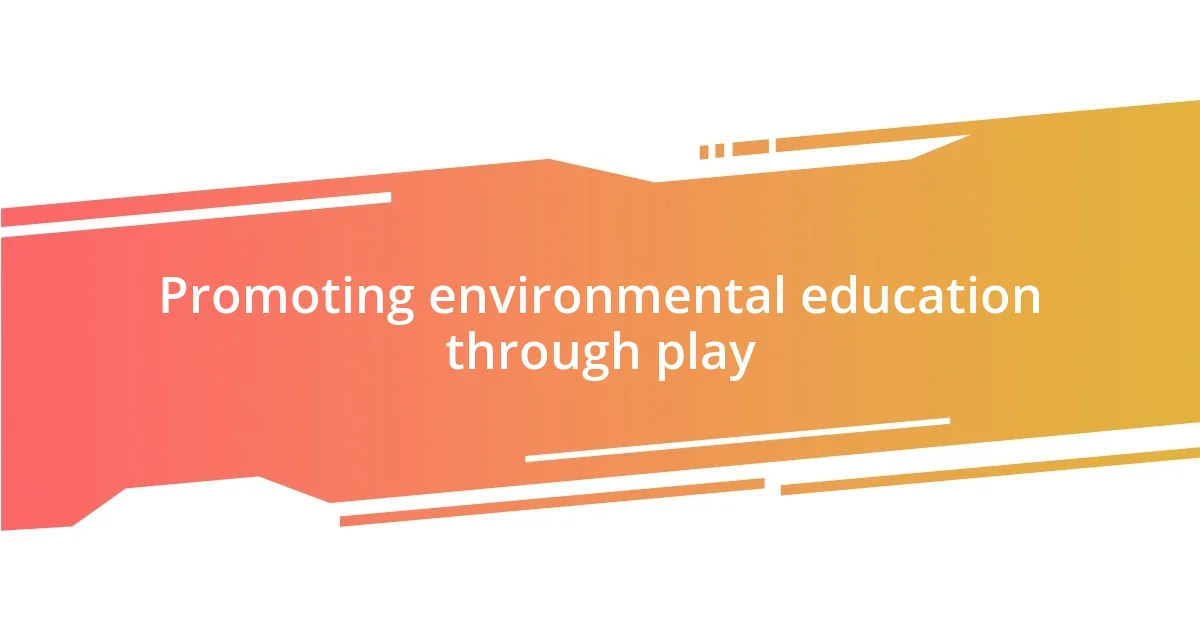
Promoting environmental education through play
Play is a powerful tool for promoting environmental education, especially through eco-conscious doll design. I remember a vibrant day at a local playdate where the children played with dolls made from sustainable materials. As they engaged in imaginative scenarios, I noticed how effortlessly they learned about recycling and the importance of taking care of our planet. Isn’t it amazing how a simple play session can spark curiosity about the environment?
In my experience, many eco-conscious brands incorporate storytelling into their doll designs to reinforce environmental themes. I once came across a doll that came with a little book about protecting oceans. During a reading session with some kids, I saw the spark in their eyes as they connected with the story. It was a heartwarming moment, as they began discussing ways to keep our beaches clean. Can you think of a better way to teach children about ecological responsibility than through play?
Moreover, I’ve often witnessed workshops where kids are encouraged to design their own eco-friendly dolls, learning about materials like organic cotton and recycled plastics along the way. I participated in a session that empowered children to think critically about their toys’ lifecycle. They were genuinely excited, realizing that every choice they made could either help or hurt the Earth. This hands-on experience makes the concept of sustainability tangible for young minds, blending fun with essential lessons in a way that nothing else can. How valuable is that for their future?
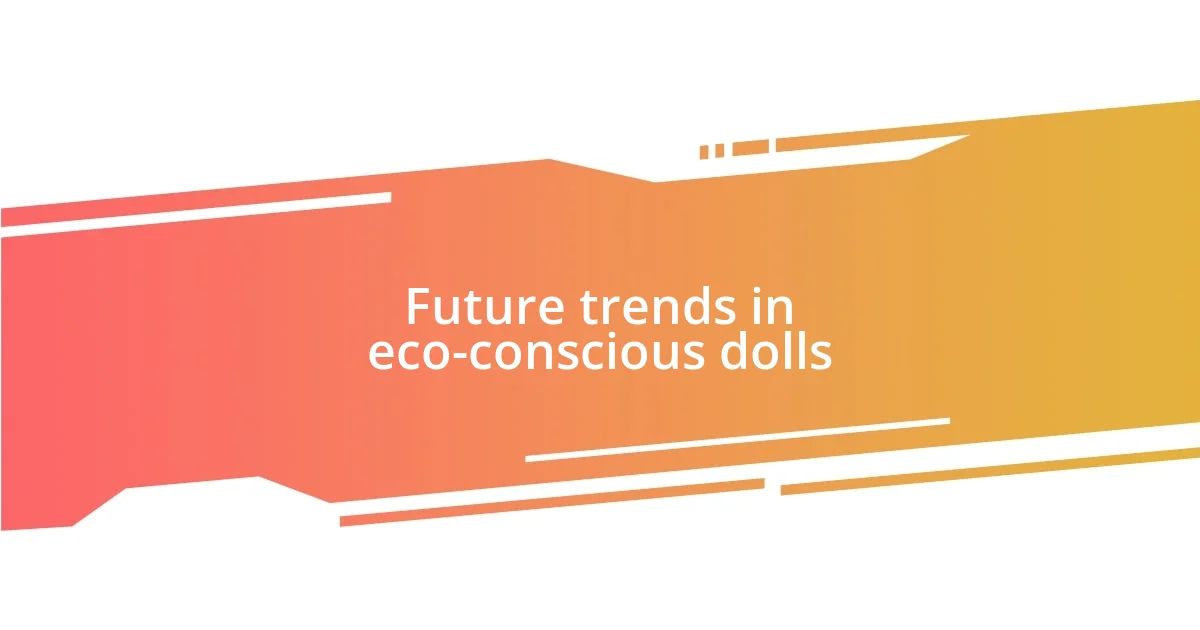
Future trends in eco-conscious dolls
The future of eco-conscious dolls is bright and bound to evolve as technology and sustainability practices advance. I’m particularly excited about the potential for 3D printing to create customizable dolls. Imagine a child being able to design their own doll, selecting eco-friendly materials and colors. I can picture how that would spark creativity and foster a sense of ownership, both for the doll and for their ethical choices. Isn’t it wonderful to envision a toy that children can truly make their own?
Moreover, the incorporation of smart technology into eco-conscious dolls could redefine playtime. I recall a moment at a toy fair where I spoke with a designer who was exploring the idea of integrating augmented reality. It allows children to connect with environmental stories that change with their doll’s journey. How dynamic would it be for a child to see their doll embark on adventures to save the rainforest, deepening their connection to real-world issues through play? I can see this captivating their imaginations while subtly teaching them about conservation.
Lastly, a growing trend is the focus on social impact through eco-conscious dolls. I attended a talk where a founder shared how every purchase contributes to reforestation efforts. Hearing about this made me reflect on how good it feels to support a brand with values that align with my own. Imagine the pride a child would feel knowing their toy is making a difference! Wouldn’t it be heartwarming if future dolls could serve not just as companions, but also as agents of change in the world?










